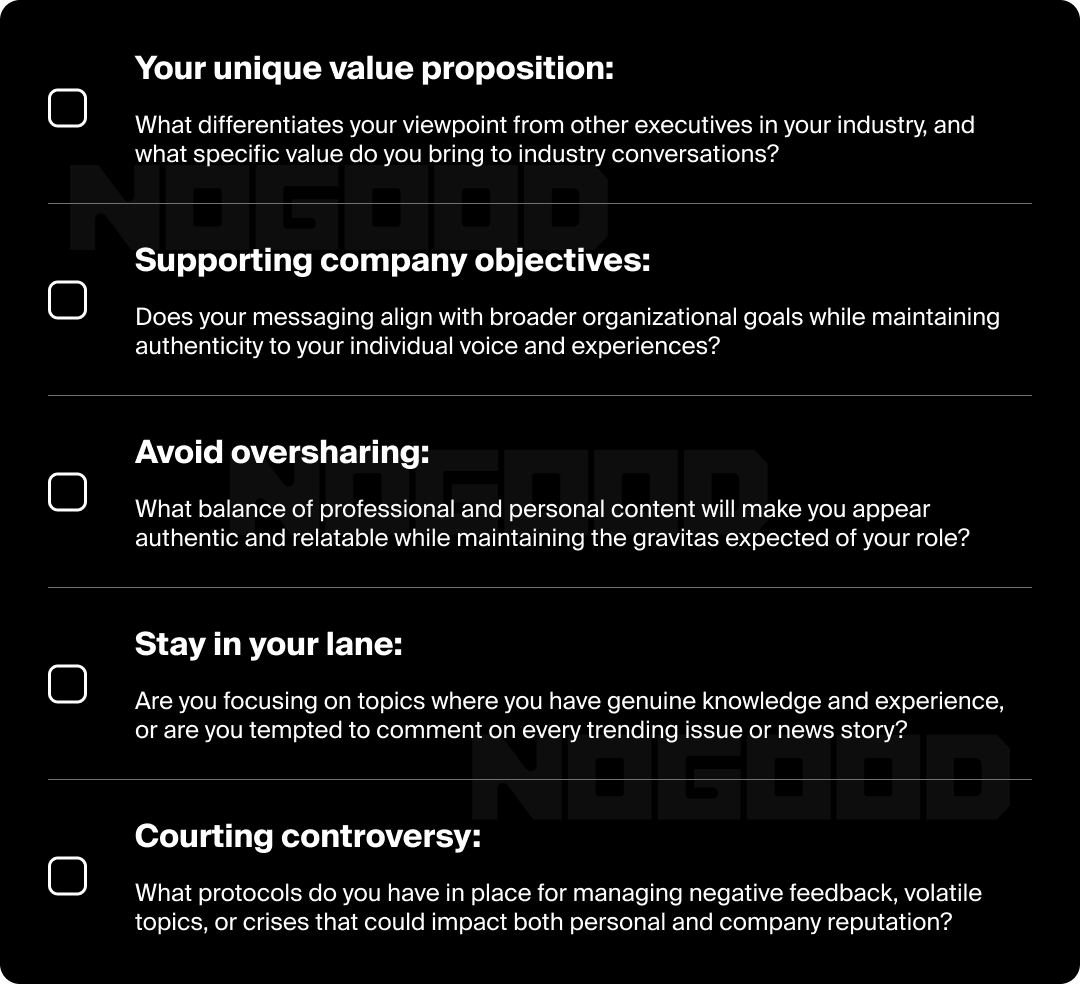Today’s founder-led growth landscape offers more accessibility to the movers and shakers of the world than ever before. Imagine being able to sit in the garage with Steve Jobs or shadow Bill Gates in some of his earliest sales meetings. While we still don’t have access to a time machine, we do have the next best thing.
Executives are actively sharing their personal experience, strategic thinking, and vision directly with audiences around the globe, effectively inviting thousands into their “virtual dorm room” as they build the next market-defining innovation.
Across newsletter subscriptions and personally-branded LinkedIn blogs, business leaders are carving out a competitive advantage by offering their distinct perspective and unique insights to stand out from the crowd.
The ability to think differently is emerging as an effective value proposition: one that can influence long-term decision-making and be the decisive factor in partnership deals.
Founders and key players at some of the most high-profile organizations in the world, including Google and Microsoft, are being incentivized to vocalize their thoughts on social media and beyond, where traditionally these valuable perspectives might have been kept confined to the boardroom or saved for a lucrative publishing contract.
As social media and thought leadership continue to emerge as essential pillars of any effective growth strategy, it’s important to consider how this tactic can be employed alongside employee advocacy and top-down transparency to improve share-of-voice and supplement traditional marketing.
If you’re curious about what effective executive thought leadership looks like and how to get started within your own organization, we have prepared this guide to help implement the right framework that supports sustainable growth and crafts a resonant narrative for prospective customers.

Effective Thought Leadership & Its Impact on Growth
Executive Thought Leadership content can come to life in many forms. Beyond sit-down interviews and on-stage appearances, key business stakeholders are forging connections with their partners and potential customers by being honest and transparent on social media.
According to Edelman’s 2024 B2B Thought Leadership Impact Study, 61% of decision-makers now place greater importance on thought leadership than traditional marketing materials when evaluating potential partners.
Even more significantly, 57% of C-suite executives have awarded business to organizations based solely on their thought leadership contributions, even when those companies weren’t previously on their radar.
The implications are clear: executive thought leadership doesn’t just enhance visibility—it creates opportunity.
And this strategy doesn’t just apply to those at the top of the corporate ladder—the results can turn into renewed and extended collaboration, new contracts, or a reliable bank of professional references.
For those just getting started in a new role or seasoned professionals looking to stay relevant in a rapidly changing industry, receiving a unique and valuable perspective on your day-to-day experience is likely in high demand.
Your company or brand likely already has a social media strategy or employee advocacy program in place, but when thinking about your own personal brand, there are a few important things to keep in mind:

Thought leadership content on social media tends to be less brief than traditional blogs and offers more impact than standard one-off posts and irregular updates. You don’t want to start posting without a clear idea of how you’re trying to move the needle and what conversations you want to be a part of.
In the next section, we’ll discuss how to set measurable goals and implement strong tactics that can help you find your voice.
Executive Thought Leadership in Action
An effective thought leadership strategy offers tangible benefits for both the individual and their organization by influencing customer trust and driving business relationships.
Individuals looking to share their own thoughts should consider the best channels to start posting on and what return-on-investment they’d like to see. This helps inform posts that could turn into repeatable, rewarding content.

Platforms to Consider
While the social media landscape is constantly evolving, thanks to the proliferation of short-form video and the oversaturation of independent content creators, LinkedIn has remained a healthy place to find high-profile people sharing their experiences.
This may be due to the inherent professional nature of the network, but even the tone-of-voice many use on LinkedIn has changed since activity on X has decreased and Instagram made changes to compete with TikTok.
LinkedIn supports long-form blog articles as well as multi-image carousels and even short video clips directly displayed in the feed. Whatever formats you decide to focus on, there’s a strong chance LinkedIn will make it easy to share. For most thought leaders looking to get started, this platform is your best choice.
If you travel frequently or have a particularly interesting office or workspace setting, you can leverage compelling visual content to diversify from the competition on a personality-driven TikTok or Instagram page. You may also consider posting in an organized group or community forum if you have an audience that’s active on Facebook.
Core Content Themes
Now that you know where you’re going to be posting, you should put some thought into what it is that you want to say. An obvious place to start is by relaying your day-to-day experience to followers who may not directly work at your company.
Think about what an average week looks like for you and make notes of the most interesting conversations or discussions you participated in. Sharing simple anecdotes from lived experience makes your role feel more public-facing and transparent, and can also reflect positively on the organization you work for.
Traveling for work also provides ample opportunity for content creation. You can share a post from the airport lobby about the next city or country you’re visiting, as well as details on the culture you’re excited to experience or memories of your last trip.
Providing an authentic, human perspective on shared experiences, such as sightseeing and trying new foods, makes it more likely that your audience will be receptive and engage with your personality.
Taking photos at trade shows and conferences is another strong way to reinforce your position. Tag the accounts of people you met for the first time, participated in a panel with, or heard give an insightful talk to maximize reach and encourage others to comment back.
There are plenty of evergreen conversation topics that you can return to to keep your posting cadence consistent as well. For example, think about your professional history and create a document that has some notes on topics including:
- How to manage a crisis at work
- Your philosophy on hiring and building a team
- Balancing work and personal life
- Reflecting on failure and how to move forward
Finding Support
When it comes to sharing thought leadership content, consistency is key. If your schedule doesn’t accommodate frequent copywriting or ideation, consider bringing an assistant or agency in to help with production. Emerging as a thought leader that courts respect and reaches new followers requires avoiding quiet periods or dips in quality, even if you have minor updates to share.
Find a regular, recurring time to set aside and review photos or summarize key takeaways you want to share on social media. You can fill out a template form that can be fleshed out or built upon by someone on your team after you get started.
When managing posting responsibilities, consider a tool that lets you share account access and keeps your login credentials secure, so another member of your team can publish posts.
Determining the balance of authorship and inspiration is different for everyone, as some leaders insist on 100% ownership of every word that goes out under their name, while others are more than comfortable handing off a bullet-point summary for a ghostwriter to take the lead on.
It’s important to ensure everything that goes live has at least one round of quality assurance feedback to ensure accuracy, confidentiality, and maintain a professional tone-of-voice.
Measuring Success
As with any social media strategy, having clear goals and objectives is instrumental in ensuring continued success.
For the first month of activity, experiment with different formats, uploading various asset types, and playing around with humor and more dramatic hooks to see what your audience responds to.
Identify top-performers and any consistent, recurring themes within those posts. Maybe you have cultivated a network that’s interested in seeing what kinds of books you read, or wants to know what podcasts you listen to on cross-country flights. Others may only be interested in hearing your takeaways from a recent sales kickoff or keynote.
Executive thought leadership content should be driving towards a clearly defined objective. For some, this may be building a reputation, and they focus on the total number of impressions and reach. If you are interested in starting conversations and being seen as an influential voice in your field, you may track the number of comments and direct messages your posts receive.
Elsewhere, broader business goals such as media attribution and share of market voice can be significantly bolstered by executives who are active on social media channels. Reviewing your content performance regularly and incorporating key learnings are important to drive success.

Implementation: From Insight to Business Impact
On average, today’s executives can share insights, build relationships, and influence decisions on a scale previously reserved for only the most visible industry figures.
However, this democratization of influence also means that excellence, authenticity, and strategic focus are more important than ever. Effective thought leadership demands a strategic approach that aligns personal brand development with organizational growth objectives.
The executives who commit to implementing comprehensive thought leadership strategies, measure their impact rigorously, and continuously refine their approach will find themselves not just participating in industry conversations but leading them, and converting that leadership into sustainable business growth.
Teams that achieve the most significant impact understand that thought leadership is not a marketing tactic but a comprehensive business strategy that touches every aspect of their organization’s market positioning.
As explored in this blog, there are various ways to begin piloting an executive thought leadership program. Staying true to your distinct perspective and following clear, measurable milestones provides a healthy foundation for your content strategy.
Whether you choose to focus on industry insights, leadership philosophy, or innovation strategies, consistency in messaging and authentic engagement with your audience remain paramount to building the trust that ultimately drives business results.
The most successful programs often involve professional support, whether through content creators, social media managers, or integrated marketing teams who can maintain quality and consistency while respecting executive time constraints.
If you’re ready to take the leap and start building your own executive thought leadership strategy, NoGood has the resources you need.






